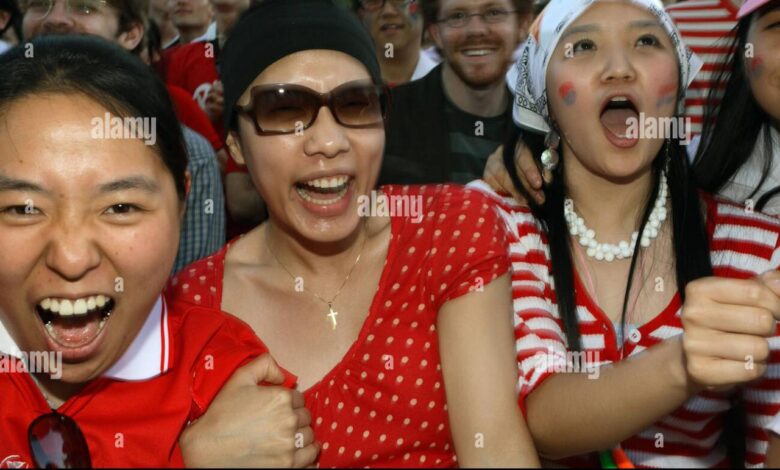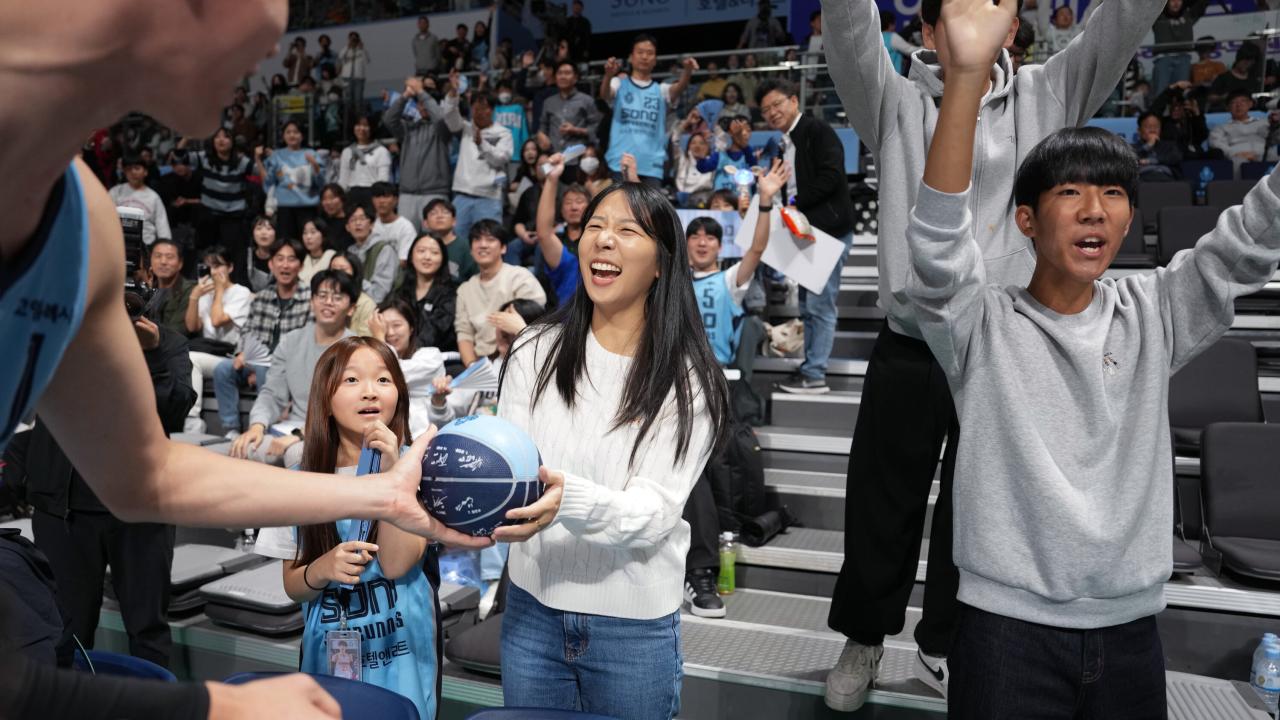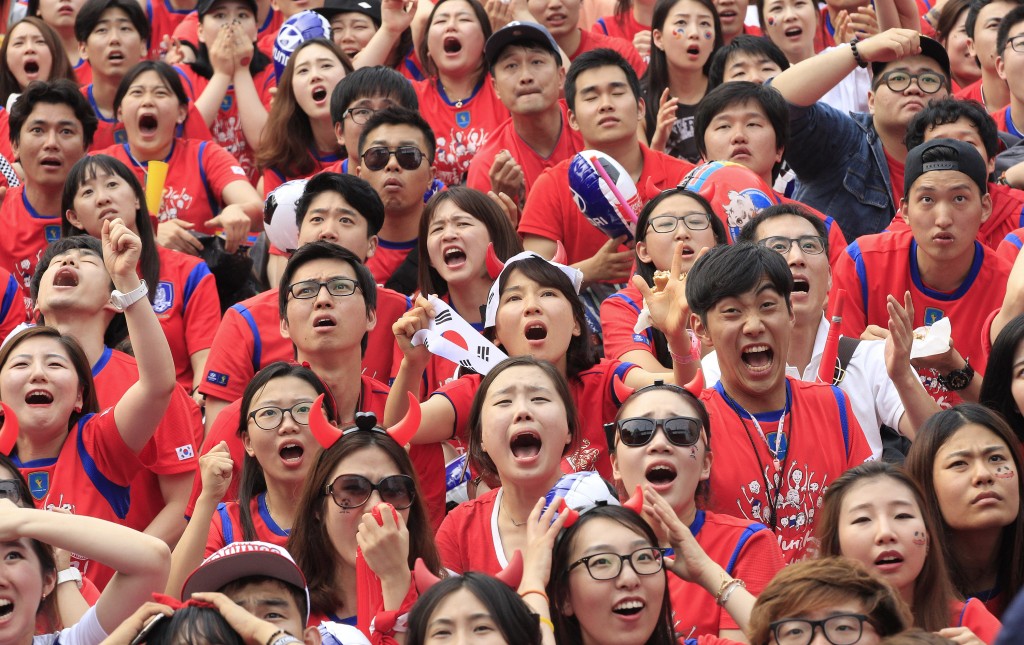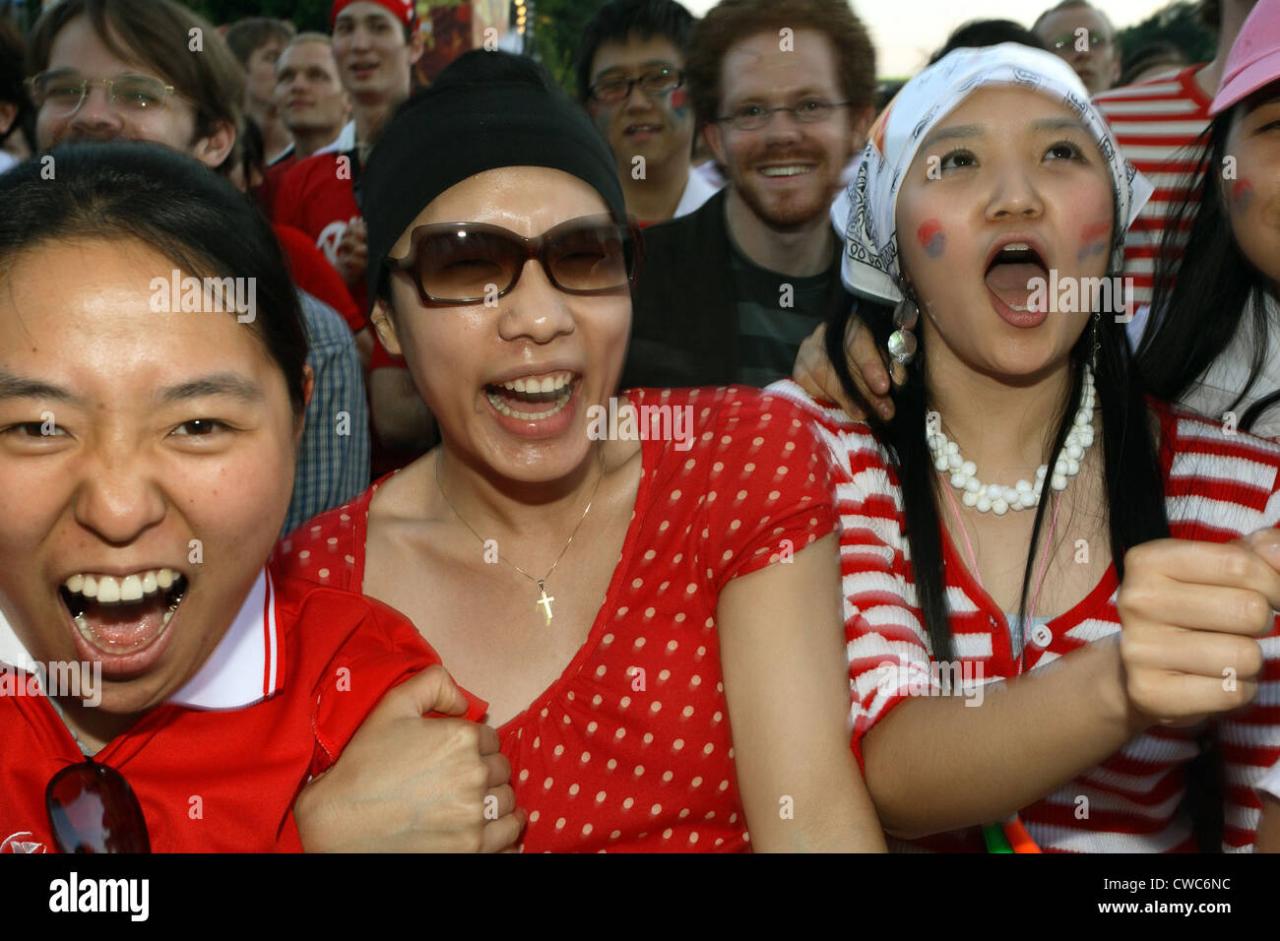
Women Sports Fans South Korea A Deep Dive
Women sports fans South Korea are passionate and growing in numbers. This exploration delves into the demographics, popular sports, and engagement patterns of these dedicated supporters. We’ll examine the historical context, motivations, and challenges faced by women’s sports in South Korea, while also highlighting the opportunities for growth.
From the dedicated fans attending games to the active social media users, we’ll uncover the vibrant world of women’s sports fandom in South Korea. The analysis will include a comparison of different sports fan bases, examining the key characteristics of their fans. It will also investigate the role of media, marketing, and sponsorships in shaping fan perception and engagement.
Overview of Women’s Sports Fans in South Korea
South Korea boasts a passionate and growing fanbase for women’s sports, a dynamic that reflects a broader societal shift towards greater gender equality and recognition of female athleticism. This enthusiasm isn’t confined to just a few sports but extends across various disciplines, highlighting a genuine appreciation for female athletes. The burgeoning fan base is fueled by a blend of factors, including increased media coverage, the rise of social media engagement, and the inspiring performances of Korean women athletes.The current state of women’s sports fandom in South Korea is characterized by a substantial, though often under-reported, presence.
Fans are increasingly vocal and active, participating in online forums, social media discussions, and in-person events. This enthusiasm is a significant development in the landscape of Korean sports.
Key Demographics of Women’s Sports Fans
South Korean women’s sports fans are a diverse group, encompassing a wide range of ages, socioeconomic backgrounds, and locations. While some sports may attract particular demographic segments, a general trend shows a growing interest across various groups.
- Age: The fan base is relatively broad, with significant representation across all age groups. While younger generations are often more engaged online, older fans frequently bring a history of support and a strong connection to traditional sports.
- Gender: While women are the primary target demographic, men are also actively involved in supporting women’s sports. This growing interest in women’s sports from the male demographic is a crucial element in the overall growth of women’s sports in the country.
- Location: Fan engagement isn’t confined to specific geographic areas. Support is evident across urban and rural areas, though urban centers often see higher concentrations of fans due to increased media coverage and access to venues.
- Socioeconomic Status: The fandom encompasses various socioeconomic backgrounds. The cost of tickets and merchandise is a factor but isn’t a deterrent for many dedicated fans. Support for women’s sports is becoming a common cultural element across various economic strata.
Most Popular Women’s Sports in South Korea
Several women’s sports enjoy significant popularity in South Korea. This is largely due to the success of Korean athletes, media coverage, and the general public’s growing interest in female athletes.
- Volleyball: Volleyball is exceptionally popular, particularly with younger fans. The high-octane action and exciting plays draw significant crowds and online engagement. South Korea has a strong tradition in volleyball and has achieved international success with both men’s and women’s teams.
- Basketball: Basketball, a globally popular sport, enjoys a strong following in South Korea. The women’s national team’s performance and media exposure play a significant role in attracting fans.
- Soccer: The women’s national soccer team’s progress and growing media attention are increasing the sport’s popularity, particularly among younger fans. The recent surge in women’s soccer in South Korea reflects a trend towards greater inclusivity and appreciation for women’s athleticism.
History of Women’s Sports Participation and Fandom
The history of women’s sports participation and fandom in South Korea is marked by a gradual but significant shift. Early involvement was often limited by societal norms and traditional gender roles. However, a notable change is occurring.
- Early Stages: Early participation was often limited by societal expectations and a lack of dedicated infrastructure. However, even in these early stages, there were dedicated women athletes and supporters.
- Modern Era: The modern era shows a growing recognition of women’s athletic achievements. Increased media coverage and the success of Korean athletes have significantly contributed to the rising popularity of women’s sports.
Fan Base Comparison
| Sport | Fan Base Size (estimate) | Key Characteristics of Fans |
|---|---|---|
| Volleyball | Approximately 5 million | Energetic, passionate, often younger fans who appreciate the fast-paced action and skillful plays. |
| Basketball | Approximately 3 million | A significant portion of fans are young and enthusiastic, mirroring the broader basketball fan base in the country. |
| Soccer | Approximately 2 million | The fan base is growing rapidly, attracting both younger and older generations with the rising success of the national team. |
Fan Engagement and Behavior

South Korean women’s sports fans exhibit a vibrant and engaged presence, demonstrating a deep connection to their favorite athletes and teams. Their engagement extends beyond simple spectator roles, encompassing active participation in online communities and social media interactions. This involvement underscores the growing importance of women’s sports in the cultural landscape of South Korea.Engagement patterns of South Korean women’s sports fans are diverse and dynamic, with a strong emphasis on online interactions.
While attendance at games remains a significant aspect of their support, the rise of online platforms has facilitated a broader and more interactive experience. This includes active participation in online forums, fan communities, and social media discussions.
Typical Engagement Patterns
South Korean women’s sports fans demonstrate a strong online presence. They frequently watch games live online, supplementing or even replacing traditional television viewership. This online engagement is further enhanced by active participation in social media, fostering a strong sense of community among fans. Dedicated fan communities, often centred around specific teams or athletes, provide spaces for interaction, discussion, and shared experiences.
South Korean women sports fans are a passionate bunch, known for their incredible energy and support. Their enthusiasm is truly inspiring, and while it’s great to see their dedication, it’s also interesting to note the recent Winthrop Poll on Haley and Trump in South Carolina winthrop poll haley trump south carolina. Hopefully, this political climate doesn’t dampen the incredible spirit of these fans as they cheer on their favorite teams.
Interactions with Athletes and Teams
Fans actively interact with athletes and teams through various channels. Direct communication, often through social media platforms, allows for personalized engagement and fosters a closer connection. This direct interaction can include questions, comments, and expressions of support. Fan events and meet-and-greets are also common avenues for interacting with their favorite teams and players.
Social Media Trends and Conversations
Social media platforms play a pivotal role in shaping conversations and trends related to women’s sports in South Korea. Discussions often focus on game analysis, player performances, and team strategies. Fan opinions and perspectives are readily shared, fostering a sense of collective passion and engagement. Social media trends also highlight the growing recognition of women’s sports, with conversations often celebrating achievements and milestones.
Impact of Social Media
Social media has significantly amplified fan engagement in South Korean women’s sports. It facilitates rapid information dissemination, enabling fans to stay updated on team news, player performances, and upcoming events. The interconnectedness fostered by social media allows for a wider reach and deeper engagement with the sport, beyond traditional media channels. This direct interaction also contributes to the growth of the fanbase, with new fans discovering and engaging with the sport through social media.
Platform Usage by Women’s Sports Fans
| Platform | Frequency of Use (Example) | Reasons for Use |
|---|---|---|
| YouTube | High | Live streaming of games, replays, and highlights |
| KakaoTalk | High | Real-time communication with friends and fellow fans, creating group chats dedicated to specific teams |
| Medium | Following athletes, sharing photos and videos, interacting with official accounts, and participating in discussions | |
| Medium | Real-time updates, expressing opinions, engaging in discussions about games and players, and sharing news | |
| Low | Joining fan groups, following official pages, sharing updates and information |
This table provides a glimpse into the varying platforms used by South Korean women’s sports fans. The frequency and reasons for using each platform highlight the diverse ways fans engage with the sport.
Motivations and Influences: Women Sports Fans South Korea
South Korean women’s sports fandom is a fascinating blend of traditional values, modern trends, and evolving societal expectations. Understanding the driving forces behind this engagement is crucial for developing effective strategies to cultivate and sustain this growing sector. This involves examining cultural influences, media portrayals, and the unique motivations that distinguish women’s sports fans from their male counterparts.The dynamics of fan engagement are complex, influenced by a multitude of factors.
This exploration delves into the key drivers, considering the unique cultural context of South Korea and how these shape fan behaviors. It further investigates the role of media and marketing in shaping perceptions and the impact of sponsorships on fan engagement. Ultimately, this analysis aims to provide a deeper understanding of the motivations behind women’s sports fandom in South Korea.
Key Factors Driving Women’s Sports Fandom
Several key factors contribute to the growing interest in women’s sports among South Korean women. A strong emphasis on family and community values often plays a significant role, with shared experiences and support networks fostering engagement. Additionally, the rising prominence of women in various fields, including sports, has empowered women to embrace their passions and support female athletes.
Furthermore, the competitive nature of South Korean society encourages engagement in sports, as reflected in the high levels of participation in both amateur and professional leagues.
Cultural and Societal Influences on Fan Behavior
South Korean culture places a high value on teamwork and community spirit, which can be readily observed in the passionate support shown for women’s sports teams. Respect for authority figures, including coaches and athletes, is another prevalent cultural characteristic that influences fan behavior. The emphasis on discipline and perseverance, values often associated with sports, resonates deeply with South Korean women.
South Korean women sports fans are a passionate bunch, known for their vibrant energy at games. Their enthusiasm is a big part of the sports scene, but it’s also interesting to consider how this enthusiasm might compare to the trends in the housing market near NYC. A recent report on housing market near nyc highlights some interesting shifts in the area, suggesting a potentially complex relationship between market forces and fan engagement.
Regardless, the dedication of women sports fans in South Korea remains undeniable.
Comparison of Motivations Between Women’s and Men’s Sports Fans
While shared interests in sportsmanship and competition exist, the specific motivations behind women’s and men’s sports fandom in South Korea show notable distinctions. Women fans often cite the inspiration and empowerment they derive from female athletes as a key factor. They frequently value the opportunity to connect with other women who share their passion for sports. This camaraderie often fosters a sense of community and support, particularly for women’s sports teams.
Men’s fandom, in contrast, might be more driven by a competitive spirit and a desire to experience the thrill of victory.
Role of Media and Marketing in Shaping Fan Perception
Media plays a pivotal role in shaping fan perception and engagement. Positive media coverage and effective marketing campaigns can create a favorable image for women’s sports, increasing awareness and interest. Television coverage of key matches, online platforms showcasing athlete stories, and dedicated social media campaigns are vital tools in influencing fan perception. These campaigns must resonate with the target audience’s values and interests to maximize impact.
South Korean women sports fans are passionate and vocal, known for their energetic support at games. While the recent news surrounding the Gaza cease fire and Russia’s role with NATO in the conflict ( gaza cease fire russia nato ) is definitely dominating headlines, it’s worth remembering the dedicated fandom of women in South Korea, and how their enthusiasm for sports is a vibrant part of the cultural scene.
Their passion is truly inspiring!
Impact of Sponsorships and Partnerships
Sponsorships and partnerships can significantly influence fan engagement. Companies that align with women’s sports values and target women’s sports fans often see positive results in brand recognition and loyalty. Sponsorships provide funding for teams, which enhances facilities and player development, indirectly affecting fan engagement. Moreover, well-executed partnerships can establish a stronger connection between brands and fans, driving participation and enthusiasm.
Correlation Between Factors and Fan Engagement
| Factor | Correlation with Engagement | Explanation |
|---|---|---|
| Cultural Values (e.g., collectivism, respect) | Strong Positive Correlation | Shared experiences and community spirit foster engagement. |
| Media Coverage (e.g., TV broadcasts, online platforms) | Moderate Positive Correlation | Exposure to athletes and events drives interest and awareness. |
| Athlete Performance | Strong Positive Correlation | Exceptional performances inspire and motivate fans. |
| Empowerment and Inspiration | Strong Positive Correlation | Female athletes often serve as role models for women. |
| Team Spirit and Community | Strong Positive Correlation | Opportunities for shared experiences increase engagement. |
Challenges and Opportunities

The vibrant world of women’s sports in South Korea, while experiencing growth, faces unique hurdles. Understanding these challenges and recognizing the opportunities for advancement is crucial for sustainable progress. The journey towards greater fan engagement and broader participation requires a multifaceted approach that considers economic factors, societal norms, and government policies.
Challenges Faced by Women’s Sports in South Korea
The Korean sports landscape, traditionally dominated by men’s professional leagues, presents several obstacles for women’s sports. Limited media coverage and sponsorship opportunities often result in less visibility and financial support for women’s teams and athletes. This lack of exposure can translate into reduced fan interest and participation. Additionally, societal expectations and traditional gender roles can impact participation rates and opportunities for women athletes.
Furthermore, the demanding training and competition schedules often conflict with the responsibilities of women in family and career settings, impacting the longevity of their athletic careers.
South Korean women sports fans are a passionate bunch, known for their vibrant support and enthusiasm. Their dedication to their teams is truly inspiring. While global events like the recent Netanyahu hostage deal in Rafah, netanyahu hostage deal rafah , dominate headlines, the fervent support of women sports fans in South Korea continues to be a powerful force within the local sporting scene.
They are a strong and vibrant part of the country’s cultural fabric.
Opportunities for Growth in the Women’s Sports Market, Women sports fans south korea
Despite the challenges, there are significant opportunities for women’s sports to thrive in South Korea. Increased media attention and coverage, particularly in the mainstream media, can significantly boost fan interest and participation. Targeted marketing campaigns aimed at younger demographics can attract new fans and cultivate a passionate following. Sponsorship deals and partnerships with corporations can provide crucial financial support, allowing women’s teams to improve infrastructure and enhance their competitiveness.
Role of Government Support and Policies in Promoting Women’s Sports
Government initiatives play a vital role in shaping the landscape of women’s sports. Policies that support infrastructure development, including stadium upgrades and training facilities, are crucial. Funding for women’s sports programs and initiatives, alongside targeted training programs and scholarships, can enhance the overall competitiveness of women’s teams and individual athletes. Moreover, policies that address gender equality and support women’s participation in sports can foster a more inclusive and equitable environment.
Impact of Economic Conditions on Women’s Sports
Economic fluctuations significantly influence participation rates and funding availability in women’s sports. During periods of economic growth, increased investment in women’s sports can occur, leading to improved facilities, salaries, and overall competitiveness. Conversely, economic downturns can negatively impact the financial resources available to women’s sports organizations, potentially leading to budget cuts and reduced opportunities.
Strategies to Increase Fan Engagement and Support for Women’s Sports
The following strategies aim to foster a more enthusiastic and supportive fanbase for women’s sports in South Korea.
| Strategy | Potential Impact | Implementation Steps |
|---|---|---|
| Targeted Marketing Campaigns | Increased awareness and fan base among specific demographics, potentially leading to increased ticket sales and merchandise purchases. | Develop engaging campaigns featuring prominent women athletes, utilize social media platforms effectively, and partner with influencers to promote events and teams. |
| Collaboration with Esports Organizations | Potential for crossover appeal, bringing in a younger demographic interested in esports to women’s sports. | Identify common ground, create co-branded merchandise, and host joint events. |
| Highlighting Stories of Success | Inspire young women to pursue athletic careers and attract wider public interest in women’s sports. | Feature success stories of prominent athletes and teams through media coverage, documentaries, and online platforms. |
Illustrative Case Studies

South Korea’s women’s sports scene is experiencing a surge in popularity, driven by passionate fans who actively engage with their favorite teams and athletes. This surge reflects a broader societal shift towards valuing women’s sports and recognizing the dedication and talent of female athletes. Understanding the dynamics of this passionate fanbase is crucial to fostering further growth and success in the industry.Analyzing specific teams and events provides invaluable insights into the characteristics and motivations of these fans, enabling us to identify effective strategies for engagement and development.
Examining successful case studies allows us to better understand how to leverage fan passion for the benefit of women’s sports in South Korea.
South Korean women sports fans are passionate and vocal, creating a vibrant atmosphere at games. Their enthusiastic support is definitely something to see, but their energy is not unlike the buzz surrounding recent contract negotiations for Andy Reid with the Chiefs, which are keeping football fans on the edge of their seats. These negotiations, detailed in this article andy reid chiefs contract negotiations , show a similar level of intense interest, demonstrating the contagious nature of sports fandom across cultures and professional levels.
This highlights the universal appeal of sports and the dedication of fans everywhere.
The KBL Women’s Basketball League: A Case Study
The KBL Women’s Basketball League is a significant example of a thriving women’s sports league in South Korea. Its growing popularity demonstrates the potential for success in the sector. The league fosters a vibrant and engaged fan base, and the fan experience is notable for its enthusiastic atmosphere.
The fan base of the KBL Women’s Basketball League is diverse, encompassing a broad range of ages, backgrounds, and interests. A substantial portion of the fans are young women and girls, inspired by the athleticism and determination of the players. The passionate support extends beyond the immediate family and friends, encompassing broader social networks and online communities.
Key characteristics of these fans include a deep appreciation for athleticism, skill, and sportsmanship. Many fans actively participate in online forums, social media groups, and discussion boards dedicated to the league, creating a strong sense of community and shared passion. Their engagement extends beyond simple cheering; they actively discuss game strategies, player performances, and league developments.
The impact of the KBL Women’s Basketball League on the overall trend of women’s sports in South Korea is substantial. The league’s popularity has spurred increased media coverage and attention, highlighting the talent and dedication of female athletes. This, in turn, has inspired more young women to pursue basketball and other sports, creating a positive cycle of growth and development.
The fan experience at KBL Women’s Basketball games is characterized by an electric atmosphere. The energy of the crowd, the excitement of the game, and the shared enthusiasm create a truly immersive and unforgettable experience. Fans are deeply invested in the success of their teams and often form strong emotional connections with the players, further driving their engagement and loyalty.
Successful strategies employed by the league to engage fans include the use of social media platforms to provide real-time updates, behind-the-scenes content, and interactive polls and contests. The league actively fosters a sense of community among fans through online forums and dedicated fan clubs. Furthermore, the league’s commitment to promoting inclusivity and accessibility resonates with a wide range of fans.
Summary of Key Learnings
| Aspect | Key Learning |
|---|---|
| Fan Base Characteristics | Diverse, passionate, engaged across various age groups and online platforms. |
| Impact on the Trend | Increased media attention, inspiration for young women, and a positive cycle of growth. |
| Fan Experience | Electric atmosphere, high level of engagement, and emotional connection with players. |
| Engagement Strategies | Leveraging social media, fostering online communities, and promoting inclusivity. |
Outcome Summary
In conclusion, women sports fans in South Korea represent a dynamic and growing force within the sports landscape. Their passion and engagement are driven by a confluence of cultural, societal, and personal factors. Understanding their motivations and challenges is crucial for fostering further growth and support for women’s sports in the country. The future of women’s sports in South Korea hinges on the continued engagement and empowerment of its dedicated fans.
FAQ Explained
What are the most popular women’s sports in South Korea?
While soccer is prominent, other popular sports include basketball, volleyball, and badminton, each with a dedicated female following.
How do socioeconomic factors influence women’s sports fandom?
Socioeconomic factors like income and education level can impact access to sporting events and the ability to engage with fans and athletes, potentially influencing fan participation and support.
What is the role of social media in connecting women sports fans in South Korea?
Social media platforms like KakaoTalk and Instagram are vital for fan interaction, creating communities, sharing updates, and fostering engagement among women sports fans.
What are the key challenges faced by women’s sports in South Korea?
Challenges include media coverage, sponsorship opportunities, and a general lack of visibility compared to men’s sports, which negatively impacts the overall growth of the women’s sports market.

